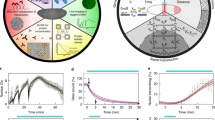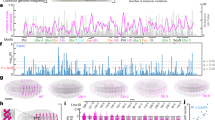Abstract
CURRENTLY there is considerable interest in determining how genes are expressed in a highly ordered sequence during morphogenesis. The main genetic approach to this problem has been to study mutants blocked in development. Such mutants are, however, highly pleiotropic; no biochemical or morphological event normally occurring after a point of mutational block is expressed1. This, coupled with inadequate knowledge of biochemical events specific to development2, and the absence of detectable cross feeding between defective mutants3, makes it difficult to determine the precise lesion in any mutant and its place in control of the sequence. Another method, selecting mutations affecting known biochemical functions can be more rewarding but is also hampered by ignorance of biochemical events relevant to development2,4.
This is a preview of subscription content, access via your institution
Access options
Subscribe to this journal
Receive 51 print issues and online access
$199.00 per year
only $3.90 per issue
Buy this article
- Purchase on Springer Link
- Instant access to full article PDF
Prices may be subject to local taxes which are calculated during checkout
Similar content being viewed by others
References
Waites, W. M., et al., Biochem. J., 118, 667–676 (1970).
Dawes, I. W., and Hansen, J. N., Crit. Rev. Microbiol., 1, 479–520 (1972).
Mandelstam, J., Symp. Soc. gen. Microbiol., 19, 377–401 (1969).
Hanson, R. S., Peterson, J. A., and Yousten, A. A., A. Rev. Microbiol., 24, 53–90 (1970).
Schaeffer, P., Millet, J. and Aubert, J. P., Proc. natn. Acad. Sci. U.S.A., 54, 704–711 (1965).
Dawes, I. W., and Mandelstam, J., J. Bact., 103. 529–535 (1970).
Miller, J. J., Nature, 196, 214–215 (1963); Can. J. Microbiol., 9, 259–277 (1963).
Dawes, I. W., and Thornley, J. H. M., J. gen. Microbiol., 62, 49–66 (1970).
Dawes, I. W., thesis, Oxford Univ. (1969).
Esposito, M. S., and Esposito, R. E., Genetics, 61, 79–89 (1969).
Dawes, I. W., and Hardie, I. H., Molec. gen. Genet., 131, 281–281 (1974).
Author information
Authors and Affiliations
Rights and permissions
About this article
Cite this article
DAWES, I. Study of cell development using derepressed mutations. Nature 255, 707–708 (1975). https://doi.org/10.1038/255707a0
Received:
Accepted:
Issue Date:
DOI: https://doi.org/10.1038/255707a0
This article is cited by
-
A mutation affecting lipoamide dehydrogenase, pyruvate dehydrogenase and 2-oxoglutarate dehydrogenase activities in Saccharomyces cerevisiae
Molecular and General Genetics MGG (1986)
-
Mutants of Schizosaccharomyces pombe which sporulate in the haploid state
Molecular and General Genetics MGG (1985)
-
Mutants of the fission yeast Schizosaccharomyces pombe which alter the shift between cell proliferation and sporulation
Molecular and General Genetics MGG (1985)
-
Cell size control of development in Saccharomyces cerevisiae
Nature (1984)
-
Inhibition of bud initiation by ethyl N-phenylcarbamate results in meiotic development in the yeast Saccharomyces cerevisiae
Archives of Microbiology (1983)
Comments
By submitting a comment you agree to abide by our Terms and Community Guidelines. If you find something abusive or that does not comply with our terms or guidelines please flag it as inappropriate.



